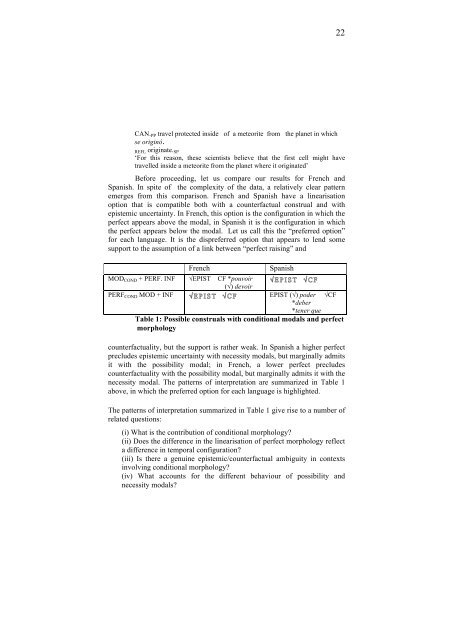On modal tenses and tensed modals - UMR 7023 - CNRS
On modal tenses and tensed modals - UMR 7023 - CNRS
On modal tenses and tensed modals - UMR 7023 - CNRS
Create successful ePaper yourself
Turn your PDF publications into a flip-book with our unique Google optimized e-Paper software.
CAN.PP travel protected inside of a meteorite from the planet in which<br />
se originó.<br />
22<br />
REFL originate.SP<br />
‘For this reason, these scientists believe that the first cell might have<br />
travelled inside a meteorite from the planet where it originated’<br />
Before proceeding, let us compare our results for French <strong>and</strong><br />
Spanish. In spite of the complexity of the data, a relatively clear pattern<br />
emerges from this comparison. French <strong>and</strong> Spanish have a linearisation<br />
option that is compatible both with a counterfactual construal <strong>and</strong> with<br />
epistemic uncertainty. In French, this option is the configuration in which the<br />
perfect appears above the <strong>modal</strong>, in Spanish it is the configuration in which<br />
the perfect appears below the <strong>modal</strong>. Let us call this the “preferred option”<br />
for each language. It is the dispreferred option that appears to lend some<br />
support to the assumption of a link between “perfect raising” <strong>and</strong><br />
French Spanish<br />
MODCOND + PERF. INF √EPIST CF *pouvoir<br />
(√) devoir<br />
PERFCOND MOD + INF √ E P I S T √ C F<br />
√ E P I S T √ C F<br />
EPIST (√) poder √CF<br />
*deber<br />
*tener que<br />
Table 1: Possible construals with conditional <strong>modal</strong>s <strong>and</strong> perfect<br />
morphology<br />
counterfactuality, but the support is rather weak. In Spanish a higher perfect<br />
precludes epistemic uncertainty with necessity <strong>modal</strong>s, but marginally admits<br />
it with the possibility <strong>modal</strong>; in French, a lower perfect precludes<br />
counterfactuality with the possibility <strong>modal</strong>, but marginally admits it with the<br />
necessity <strong>modal</strong>. The patterns of interpretation are summarized in Table 1<br />
above, in which the preferred option for each language is highlighted.<br />
The patterns of interpretation summarized in Table 1 give rise to a number of<br />
related questions:<br />
(i) What is the contribution of conditional morphology?<br />
(ii) Does the difference in the linearisation of perfect morphology reflect<br />
a difference in temporal configuration?<br />
(iii) Is there a genuine epistemic/counterfactual ambiguity in contexts<br />
involving conditional morphology?<br />
(iv) What accounts for the different behaviour of possibility <strong>and</strong><br />
necessity <strong>modal</strong>s?

















